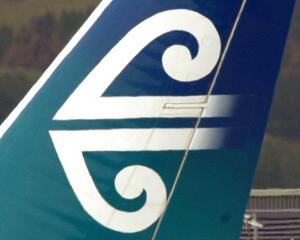Air New Zealand has reported a strong start to the financial year on the back of growing passenger numbers, cargo volumes and yields, but brokers fear its performance could be hit by the Christchurch earthquake.
The national airline yesterday reported a 9% lift in operating revenue to $2.236 billion for the six months to December 31 and a 75% lift in net profit after tax from $56 million to $98 million.
Normalised earnings, before tax and after excluding the net effect of derivatives from hedge exposures in other reporting periods, was 17% higher at $112 million.
It also included an $18 million gain on equity swaps associated with the Virgin Blue investment and net hedge losses of $75 million.
Adjusted operating cash flows rose 27% to $210 million, but net cash fell 14% to $940 million, reflecting the higher costs associated with increased capacity, rising fuel prices and foreign exchange losses.
Earnings before tax were $115 million, up from $84 million for the previous corresponding period.
An interim dividend of 3c a share has been announced, the same as for the previous corresponding period, which is worth $24 million to the Government, which holds 74% of the shares.
Forsyth Barr described it as a "good result" but warned rising fuel costs would have an effect .
But the looming Rugby World Cup, the transtasman alliance with Virgin Blue, and ongoing recovery in tourism would be positive for the airline.
Craigs Investment Partners broker Peter McIntyre said the result was broadly in line with expectations, and while key indicators were positive, investors were nervous about the effect of soaring fuel prices and the $50 special air fares to and from Christchurch after the earthquake.
The share price fell 4c early yesterday but then recovered to close trading down 2c.
Mr McIntyre said while the net profit was higher than forecast, the dividend was less.
Air New Zealand chief executive Rob Fyfe said the airline's focus was supporting those hit by the earthquake and, while it had not suffered any material damage, no assessment had been made of the commercial effect.
The number of passengers carried by the group in the year under review rose 7.8% from 6.3 million to 6.8 million while the load factor rose two percentage points from 81.6% to 84.2%.
Mr Fyfe said the airline was benefiting from initiatives that had strengthened the company's competitive position.
"Bookings on our Tasman and Pacific Island services have increased 15% since the introduction of the Seats to Suit product, performing far better than we expected," Mr Fyfe said.
That was aided by the alliance with Virgin Blue.
Domestic passenger numbers were up 8% on the corresponding period last year.
"Cargo revenue has recovered, up 13% compared to last year, volumes were up 6% on a small capacity increase and a strong 10% increase in yields."
That improvement was achieved in all markets but led by the Pacific and Asian routes.
Total passenger load increased by 2.6 percentage points over the corresponding period last year, and group yield rose 3%, prompting the airline to increase capacity by 2.7% capacity on the back of a 6% lift in demand.
Breaking down the airline's performance, it carried 2.9% more long-haul passengers - 880,000 compared with 850,000 - a 1.3 percentage point increase in load, from 83.3% to 84.6%.
The number of short-haul passengers carried rose 8.6%, from 5.5 million to 5.9 million, and the load factor from 79.2% to 83.7%.
Mr Fyfe said gearing improved 4.5% to 42.8%.


